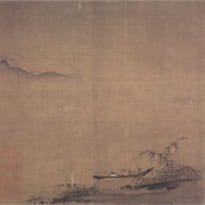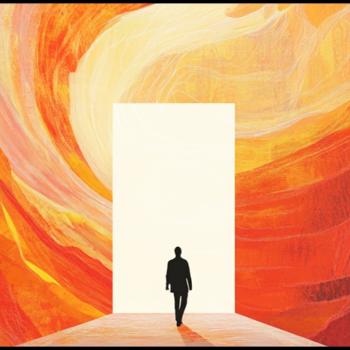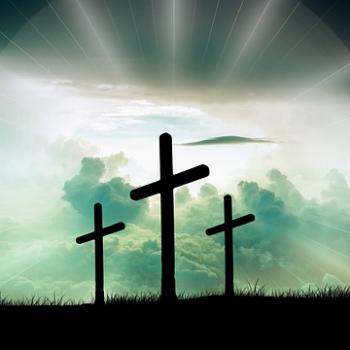Consider the contrast between Christian art and Taoist art. Almost any classical Christian art will portray Jehovah or Jesus or angels or some saint. It will make reference to some narrative or bit of doctrine. The Sistine Chapel's portrayal of the Creation, Leonardo's "Last Supper," any given painting of the Crucifixion, or Madonna and Child, or the nasty death of some martyr: they all assume some familiarity with the Christian mythos, and seek to inspire the viewer relative to that. Its appeal to someone not familiar with the narrative can be limited.
I'm reminded of the Star Trek: The Next Generation episode where Captain Picard is stranded on a planet with an alien whose language consists solely of references to his culture's mythos — mysterious utterances like "Shaka, when the walls fell!" Entirely comprehensible to his fellows, but baffling to the Enterprise crew.
Lest the reader think I am singling out Christianity, the same applies to much of Buddhist art. The painting on my wall of a pop-eyed bearded man standing surfboard-style on a reed is meaningless to someone not familiar with the story of Bodhidharma, but it serves to remind me of certain characteristics of that red-bearded barbarian. This theoretical aspect of art is a fine and useful thing, but it is not the entirety of art or of human experience.
In contrast we have the Taoist tradition of naturalistic art. (This is also true of much Zen art, as Zen is a descendant of Chinese Taoism as well as of Indian Buddhism.) A Taoist painting makes no reference to history or myth, but instead attempts to convey something about the nature of things, to evoke an aesthetic experience. Yes, if we want to play art critic or historian it's useful to know a little about the concepts of yin and yang or to be able to quote the Tao Te Ching, but one doesn't need any such knowledge to be moved by the grandeur of a landscape view or the mystery of a boat on misty river.
Such works attempt to evoke a moment of what Zen calls "mushin," "no mind"; "mind" in this context refers to the theoretical, intellectual, voice-in-the-head sort of consciousness, so necessary to getting things done but so incapable of producing satisfaction on its own. Joseph Campbell explained this sort of experience as one which "evokes in us a sense of existence" as opposed to "an assurance of meaning." (See Campbell, p. 186.)
...[E]ven a brief shock (say, for example, when discovering the moon over city roofs or hearing a sharp bird cry at night) can yield an experience of the order of no-mind: that is to say, the poetical order, the order of art.... In fact, both the magic of art and the art of magic derive from and are addressed to experiences of this order. Hence the power of the meaningless syllables, the mumbo jumbo of magic, and the meaningless verbalizations of metaphysics, lyric poetry, and art interpretation. They function evocatively, not referentially; like the beat of a shaman's drum, not like a formula of Einstein.... [W]e have had, for an instant, a sense of existence: a moment of unevaluated, unimpeded, lyric life — antecedent to both thought and feeling; such as can never be communicated by means of empirically verifiable propositions, but only suggested by art. (Campbell, pp. 186-187)
Operating evocatively, the Taoist artist may speak of "becoming one" with their subject: losing their "self," opening up to the aesthetic experience, and in so doing being able to put the "soul" of a their subject on paper (Northrop, pp. 340-341). As Northrop puts it, "in their paintings they portray the aesthetic manifold primarily, and the external three dimensional objects, which Westerners tend to seek for in these paintings, only incidentally, if at all" — recording an experience rather than a set of objects (Northrop, p. 330).
The Kamakura Daibutsu was probably intended by its sculptor to symbolize some theoretical aspects of one or another school of Buddhism. But in wiping out the temple, the hand of nature turned viewing the statue into an overwhelming aesthetic experience. An old wall conceals the Daibutsu as one enters the temple grounds; and so when the viewer turns the corner and beholds the huge old thing out under the vast sky, reflecting direct sunlight, a companion-piece to the hills and the trees, the immediate experience can be the sort of which Campbell speaks — a brief shock that momentarily silences the jabbering monkey-mind, a crack in time through which the Pure Light may shine directly, with little reference to the theoretical or verbal doctrines of Buddhism. The combination of the sculptor, history, and natural forces have created the possibility of an experience of enlightenment.
Or perhaps not. Perhaps by writing about it I have ruined the shock for you; if you should travel to Kamakura and fail to have a mystical experience upon your viewing of the Daibutsu, I'm sorry. (No refunds.)
 |
| Boating Near Lake Shore with Reeds, Southern Song Dynasty, c. 13th-century, artist unknown; via University of Oregon Libraries, public domain |




